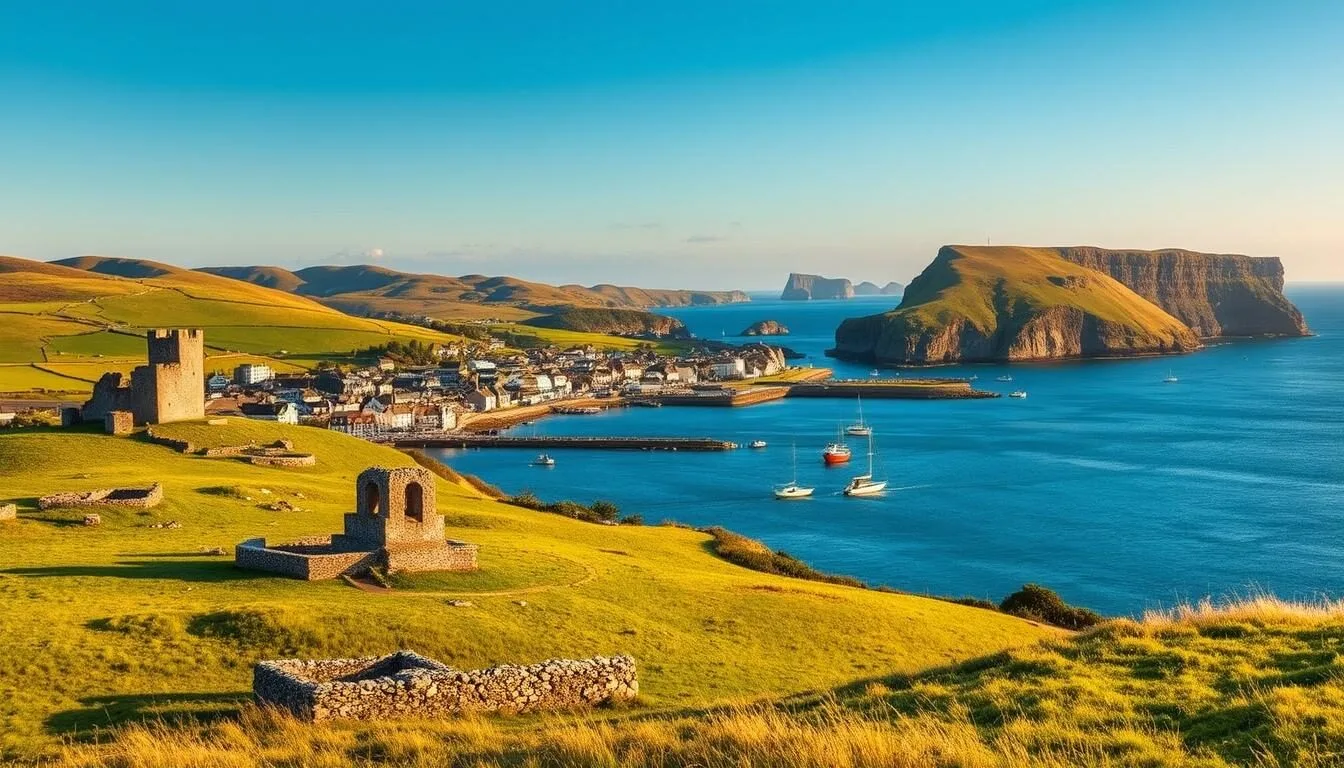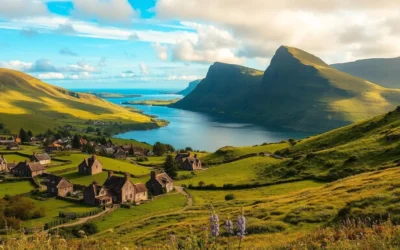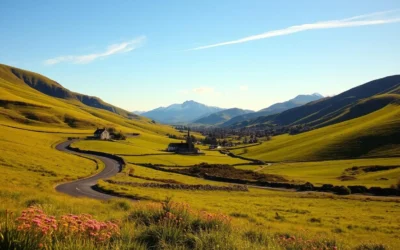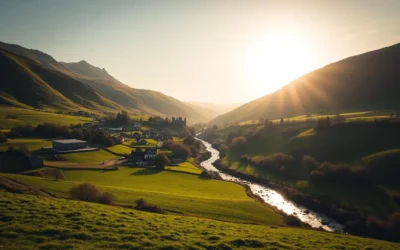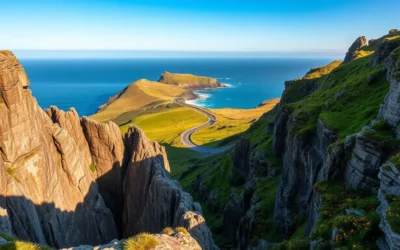✓ Accommodations✓ Flights✓ Rental Cars
Imagine strolling through a historic city in Northern Ireland, surrounded by stunning landscapes and rich cultural heritage. As you explore this captivating region, you’ll uncover a treasure trove of attractions that go beyond the typical tourist spots.
While many visitors flock to Belfast and the Antrim Coast, there’s so much more to discover in Ulster. From iconic landmarks to hidden gems, this region is a paradise for history buffs, nature lovers, and adventure seekers alike.
You’ll experience the warm hospitality of the locals, and enjoy the unique blend of cultures that make Northern Ireland so special. Get ready to create unforgettable memories as you explore the best things to do in this incredible region.
Discovering the Magic of Ulster
Your adventure in Ulster begins with exploring the six counties of Northern Ireland, each offering a unique blend of history, culture, and natural wonders. As you journey through this enchanting region, you’ll find that Ulster is more than just a destination – it’s an experience.
The Six Counties of Northern Ireland
Ulster is a historical province that encompasses the six counties of Northern Ireland: Antrim, Armagh, Down, Derry, Tyrone, and Fermanagh. These counties, along with three in the Republic of Ireland (Donegal, Cavan, and Monaghan), form a rich tapestry of history and culture. In Northern Ireland, you’ll find a different currency (British Pound), metric system, and road signs compared to the Republic of Ireland, which is essential to know before your journey.
- Antrim: Known for its stunning coastal routes and the Giant’s Causeway.
- Armagh: Often referred to as the “Orchard County” for its apple orchards.
- Down: Famous for its beautiful beaches and the Mourne Mountains.
- Derry: Rich in history, with its ancient city walls and the Derry City Walls.
- Tyrone: Home to the Sperrin Mountains and the Ulster American Folk Park.
- Fermanagh: Characterized by its picturesque lakes and the Marble Arch Caves.
Best Time to Visit Ulster
The best time to visit Ulster is during late spring (May-June) and early fall (September), when you’ll enjoy milder weather, fewer crowds, and the natural beauty of the landscape in full bloom or autumn colors. Summer months bring the warmest temperatures and longest daylight hours but also the most tourists. Winter offers a quieter experience with the possibility of seeing the Northern Lights in County Londonderry.

Understanding Ulster’s complex history helps appreciate its cultural significance, from ancient Celtic settlements to Viking invasions, the Plantation of Ulster, and the more recent Troubles period that has shaped the region’s identity. As you plan your visit, consider the time of year that best suits your preferences for weather and crowd levels.
The Causeway Coastal Route
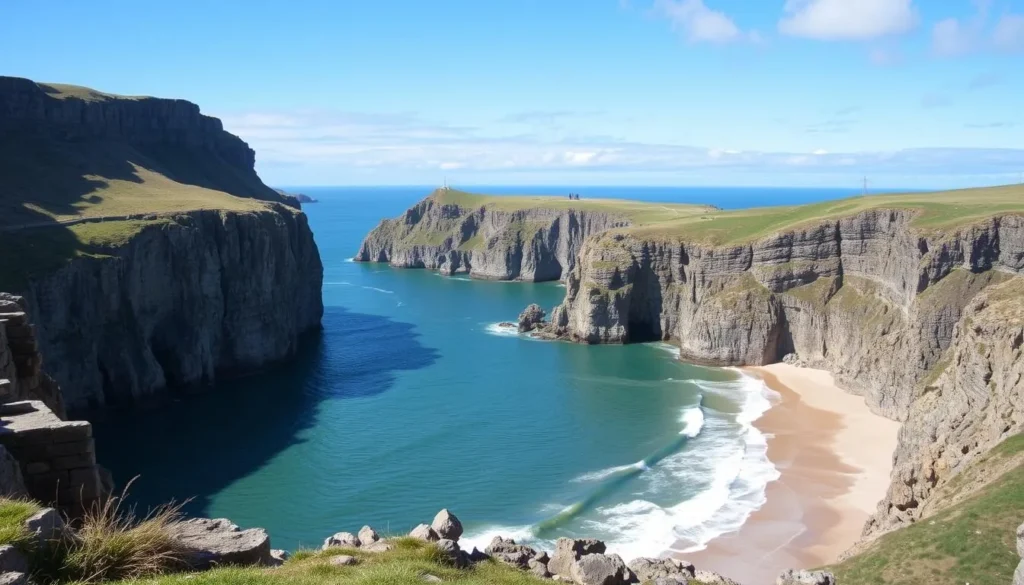
Embark on a journey along the Causeway Coastal Route, one of Northern Ireland’s most spectacular attractions. This 120-mile drive between Belfast and Derry is an incredibly scenic journey that takes you past many of the best things to do in Northern Ireland.
While it’s technically possible to drive the route in one day, we recommend giving yourself at least two to three days to fully experience its magic. This allows time to explore quaint villages, tackle scenic hikes, and enjoy the breathtaking views along the way.
Planning Your Coastal Journey
To make the most of your trip, plan your coastal journey by mapping out key stops like Giant’s Causeway, Dunluce Castle, and Carrick-a-Rede Rope Bridge. Consider overnight stays in charming coastal towns to soak up the local atmosphere.
Some of the top attractions along the route include the iconic Giant’s Causeway, a UNESCO World Heritage Site, and the dramatic Carrick-a-Rede Rope Bridge. Be sure to take some of the marked detours off the main route to discover hidden gems and less crowded spots.
Must-See Stops Along the Route
The Causeway Coastal Route offers some of the most breathtaking views in all of Ulster, with countless photo opportunities of rugged cliffs, pristine beaches, and the wild Atlantic Ocean. Be sure to stop at the Giant’s Causeway, Dunluce Castle, and the Carrick-a-Rede Rope Bridge to experience the best of Northern Ireland’s coastline.
With its stunning natural beauty and rich history, the Causeway Coastal Route is a must-visit destination for anyone traveling to Northern Ireland. Whether you’re interested in history, nature, or simply experiencing the local culture, this route has something for everyone.
Giant’s Causeway: A UNESCO World Heritage Site
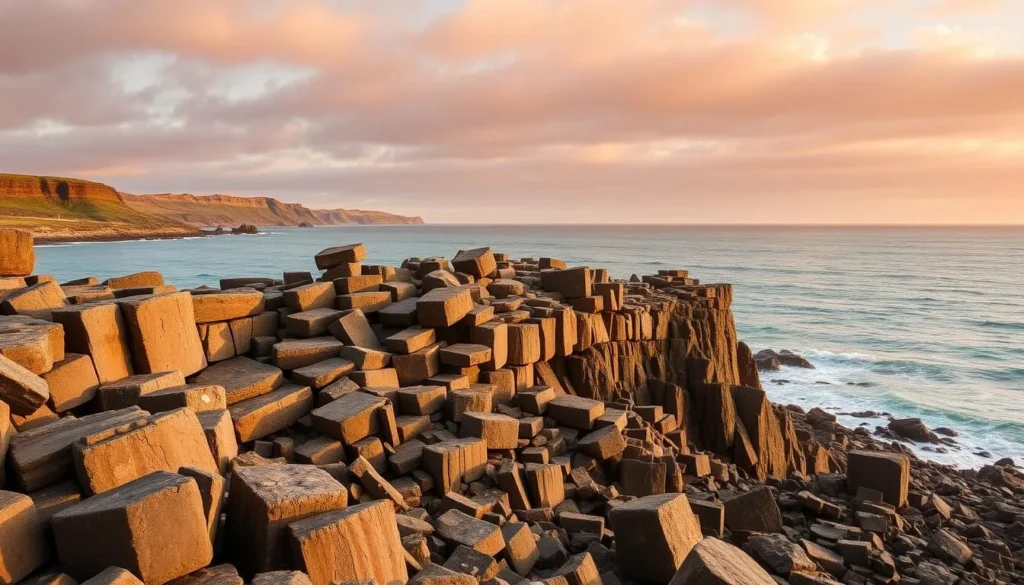
With its unique interlocking basalt columns, the Giant’s Causeway is an awe-inspiring destination that embodies the essence of natural beauty. As you explore this natural wonder, you are surrounded by over 40,000 columns, a result of volcanic activity that occurred between 50 and 60 million years ago.
The Legend Behind the Causeway
According to local legend, the Giant’s Causeway was built by the giant Fionn mac Cumhaill, also known as Finn McCool, to cross the Irish Sea and battle Benandonner, a Scottish giant. This mythological story adds a layer of intrigue to the site, making it a fascinating visit for those interested in history and folklore.
Tips for Visitors
To make the most of your visit to the Giant’s Causeway, consider arriving early in the morning or late in the afternoon to avoid the crowds. Parking at the Causeway Coast Way Car Park is recommended, as it is a 10-minute walk from the site and costs £10 per car, which is more economical than the “Visitor Experience” tickets that include parking at the visitor centre.
- The Giant’s Causeway stands as Northern Ireland’s most iconic natural wonder and a UNESCO World Heritage site, formed between 50-60 million years ago through volcanic activity that created over 40,000 interlocking basalt columns.
- According to local legend, the causeway was built by the giant Fionn mac Cumhaill (Finn McCool) to cross the Irish Sea and battle Benandonner, a Scottish giant, adding a mythical dimension to this geological marvel.
- Take time to explore the different formations with their quirky names like the Chimney Stacks, the Giant’s Boot, and the Organ, each with its own story connected to the Finn McCool legend.
- For the best visitor experience, arrive early morning or late afternoon to avoid the largest crowds, and consider parking at the Causeway Coast Way Car Park (£10) rather than purchasing the pricier “Visitor Experience” tickets.
- The site is accessible year-round, but be prepared for changeable weather conditions by bringing layers and waterproof clothing to fully enjoy this natural wonder regardless of when you visit.
As you take time to explore the Giant’s Causeway, you will uncover the rich history and natural beauty that make it a must-visit destination in Northern Ireland. The site offers an unforgettable experience for visitors, with its unique geological formations and the captivating legend of Finn McCool.
Belfast City: Beyond the Stereotypes

In Belfast, Northern Ireland’s capital, you’ll uncover a city transformed. Once marred by stereotypes, Belfast has emerged as a vibrant cultural hub, rich in history and full of life.
The Titanic Quarter
The Titanic Quarter is a must-visit, with the award-winning Titanic Belfast museum at its heart. Here, you’ll find interactive exhibits that bring the story of the Titanic to life, showcasing Belfast’s shipbuilding history.
Cathedral Quarter and City Hall
The Cathedral Quarter is the city’s cultural heartbeat, featuring cobbled streets lined with art galleries, trendy restaurants, and traditional pubs. It’s also home to the stunning St. Anne’s Cathedral. Nearby, Belfast City Hall stands as a proud example of Baroque Revival architecture, offering free guided tours and hosting the popular Christmas markets in its beautiful grounds.
Black Cab Tours: Understanding Belfast’s History
For a deeper understanding of Belfast’s complex history, take a Black Cab Tour. Local drivers share their personal perspectives on the Troubles, guiding you through the powerful political murals along Falls Road and Shankill Road. This is an unparalleled experience that provides insight into the city’s turbulent past.
Belfast is a city that’s rich in history and full of life. From its innovative quarters to its historical landmarks, there’s something for everyone. As you explore this vibrant city, you’ll find that Belfast is a place where history and culture come alive.
Majestic Mountains and Forest Parks
As you venture into the heart of Northern Ireland, you’ll discover the majestic beauty of its mountains and forest parks. The region is home to some of the most breathtaking landscapes in the world, offering a mix of adventure and tranquility.
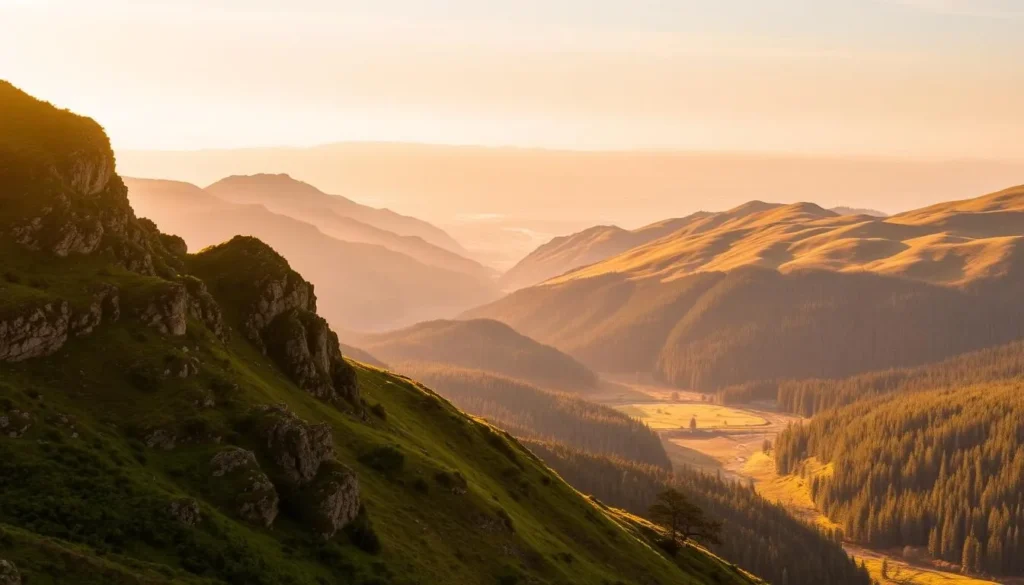
The Mourne Mountains: Inspiration for Narnia
The Mourne Mountains are Northern Ireland’s most impressive mountain range, crowned by Slieve Donard, the region’s tallest peak at 850 meters. The dramatic landscapes and natural beauty of these mountains directly inspired C.S. Lewis when creating the magical world of Narnia. Hikers of all levels can enjoy the numerous trails across the Mournes, from challenging climbs to more moderate walks with spectacular views of the surrounding countryside and Irish Sea.
The Mournes offer an adventure like no other, with trails varying in length and difficulty. Whether you’re a seasoned hiker or just looking for a leisurely stroll, the Mourne Mountains have something for everyone.
Tollymore and Glenariff Forest Parks
Tollymore Forest Park, spanning over 1,500 acres at the foot of the Mournes, offers four marked trails through ancient woodland, alongside Gothic stone arches and bridges. Glenariff Forest Park, known as the “Queen of the Glens,” provides a different forest adventure with its spectacular waterfall walks and 247 acres of woodland.
| Forest Park | Size (acres) | Features |
|---|---|---|
| Tollymore | 1,500 | Ancient woodland, Gothic stone arches, bridges |
| Glenariff | 247 | Waterfall walks, woodland, scenic trails |
Both Tollymore and Glenariff Forest Parks showcase the diverse natural beauty of Northern Ireland, offering visitors a chance to explore the great outdoors and create unforgettable memories.
Game of Thrones Filming Locations
Northern Ireland’s stunning landscapes played a pivotal role in bringing the world of Game of Thrones to life. With 25 filming locations scattered across Ulster, fans of the show can now visit these iconic sites, reliving their favorite moments from the series.
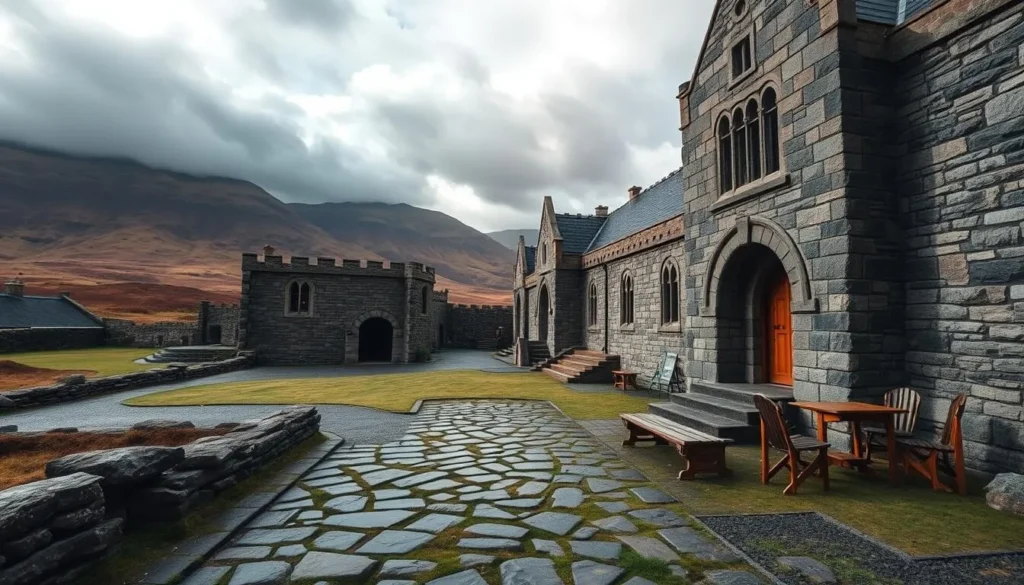
The Dark Hedges and Winterfell
At the Dark Hedges in County Antrim, you’ll find one of the most photographed natural phenomena in Northern Ireland – a haunting avenue of intertwined beech trees that served as the Kingsroad in the series. If you’re a fan of the Starks, Castle Ward in County Down is a must-visit, as it was used to film Winterfell, the ancestral home of House Stark.
Here, you can participate in immersive experiences, including archery in the same spot as Jon Snow and Robb Stark. Tollymore Forest Park, another key location, served multiple purposes in the show, including the Haunted Forest beyond the Wall and the Wolfswood near Winterfell.
Game of Thrones Studio Tour
The recently opened Game of Thrones Studio Tour in Banbridge offers the ultimate fan experience. You’ll find original sets, costumes, and props from the show, allowing you to step behind the scenes of the world’s biggest TV production. This is a unique opportunity to delve deeper into the making of Game of Thrones and enjoy an unforgettable experience.
Northern Ireland’s role in Game of Thrones is undeniable, and its locations have become pilgrimage sites for fans worldwide. Whether you’re team Stark or just a lover of the series, you’ll find that Northern Ireland has a wealth of Game of Thrones experiences waiting for you.
Ulster, Ireland: Best Things to Do for History Buffs
For those fascinated by the past, Ulster presents some of the best things to do in Northern Ireland, rich in historical significance. With a history that spans thousands of years, Ulster is a treasure trove for history buffs.
Castles of Northern Ireland
Northern Ireland is home to numerous castles that tell the story of centuries of conquest and conflict. Carrickfergus Castle, dating back to 1177, is one of the most famous and well-preserved medieval structures in Ireland. You can explore its imposing walls and towers, gaining insight into the region’s turbulent past.
Other notable castles include Dunluce Castle, perched dramatically on coastal cliffs, and Belfast Castle, with its Scottish baronial architecture and manicured gardens. Each castle offers a unique perspective on the history of Northern Ireland.
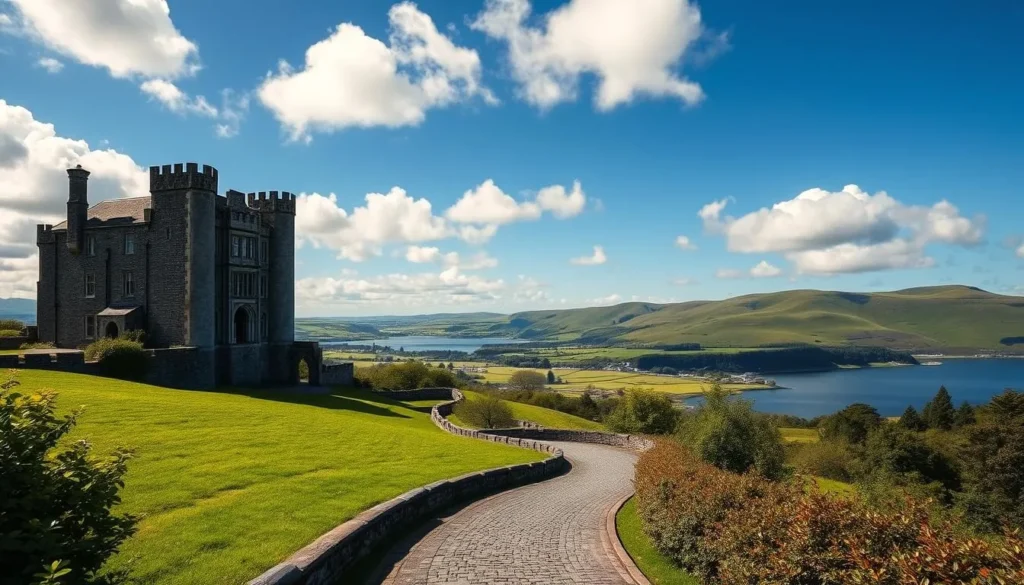
Crumlin Road Gaol and St. Patrick’s Cathedrals
In Belfast, the Crumlin Road Gaol is a must-visit for those interested in the region’s more recent history. This former jail operated for 150 years until 1996, housing a wide range of prisoners, from suffragettes to political detainees during the Troubles. Guided tours through its cells and execution chamber offer a poignant glimpse into this period.
In Armagh, known as the ecclesiastical capital of Ireland, you can visit both St. Patrick’s Cathedrals—one Roman Catholic and one Church of Ireland. Each cathedral has its unique architecture and history, dating back to the time when St. Patrick established his church on the hill. These sites are significant not only for their historical value but also for their spiritual importance.
Ulster’s historical sites provide a window into the past, allowing visitors to step back in time and experience the region’s complex history firsthand. Whether exploring ancient castles or visiting significant religious sites, you’ll be immersed in the history that has shaped Northern Ireland over the years.
Natural Wonders of Ulster
The natural wonders of Ulster are a testament to the region’s diverse geological history and breathtaking landscapes. Northern Ireland’s Ulster region is renowned for its natural beauty, offering a plethora of exciting experiences for visitors.
The Glens of Antrim
Stretching along the Causeway Coast, the nine Glens of Antrim are valleys of exceptional beauty, steeped in history and myth. Glenariff, known as the “Queen of the Glens,” enchants with its forest trails and waterfalls, while Glenaan holds Oisin’s Grave, tied to ancient Irish folklore. Each glen offers something unique, from scenic coastal villages to rugged mountain views, making them an unmissable part of any Northern Ireland adventure.
- Glenariff Forest Park offers scenic walks and picturesque waterfalls.
- Glenaan is steeped in ancient Irish mythology.
- Glenarm boasts a stunning castle and gardens.
Marble Arch Caves and Cuilcagh Boardwalk Trail
The Marble Arch Caves are a series of limestone caves and underground rivers at the foothills of Cuilcagh Mountain. Although only 1.5km are accessible during tours, the cave and river system extends 11km underground, showcasing Northern Ireland’s unique geological diversity. The Cuilcagh Boardwalk Trail, affectionately nicknamed “Ireland’s Stairway to Heaven,” offers a unique 11km hiking experience across Northern Ireland’s largest blanket bog, culminating in panoramic views from the mountain summit.
These natural attractions provide some of the most spectacular views in Ulster while also offering adventure opportunities ranging from gentle walks to more challenging hikes, all while protecting fragile ecosystems. The Marble Arch Caves Global Geopark is Northern Ireland’s only UNESCO World Heritage site for natural heritage, featuring an extensive underground network of rivers, waterfalls, and limestone formations.

Coastal Gems and Beaches
As you explore the stunning coastline of Northern Ireland, you’ll discover hidden gems that are just as breathtaking as the Giant’s Causeway. The region is home to a diverse range of coastal features, from dramatic cliffs to pristine beaches.
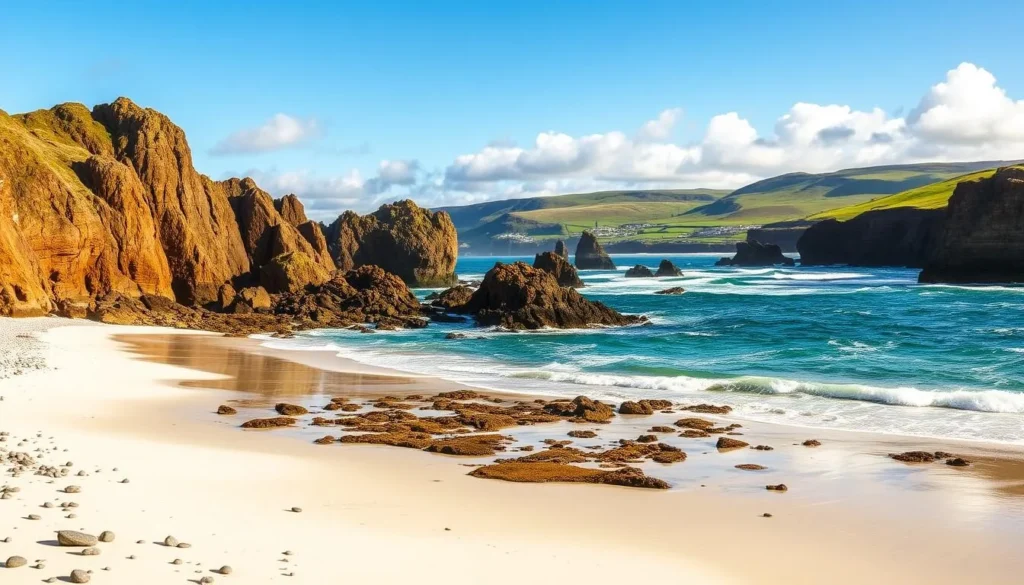
Carrick-a-Rede Rope Bridge
One of the most thrilling experiences you can have on Northern Ireland’s coastline is crossing the Carrick-a-Rede Rope Bridge. Originally built by salmon fishermen in 1755, this 20-meter span suspended 30 meters above the water is a must-visit attraction. Take time to explore the small island once you’ve crossed the bridge, where a lonely whitewashed cottage stands as a testament to the fishing heritage that continued until 2002.
Portstewart Strand and Murlough Beach
Northern Ireland is also home to some of the most beautiful beaches in the world. Portstewart Strand is a gorgeous Blue Flag beach managed by the National Trust, stretching for 3.2km along the Causeway Coast. The beach features fine golden sand and abundant wildlife, making it a perfect spot for nature lovers. Murlough Beach, on the other hand, is an expansive 6.4km-long beach in County Down that sits in the shadow of the mighty Mourne Mountains.
Whether you’re looking to relax on the beach or explore the dramatic coastline, Northern Ireland has something for everyone. With its rich history, stunning natural beauty, and friendly locals, it’s a destination that will leave you with unforgettable memories.
Unique Experiences and Hidden Gems
Beyond the well-known sights, Northern Ireland is home to many secret spots just waiting to be explored. You’ll find that these lesser-known destinations offer a more authentic experience of the local culture and landscapes.
The Gobbins Cliff Path
The Gobbins Cliff Path is an exhilarating coastal walk that stands out for its unique features. As you traverse bridges, tunnels, and paths carved directly into the basalt cliffs, you’ll be treated to breathtaking views of the Atlantic Ocean. This adventure is not for the faint-hearted, but it’s an unforgettable experience that brings you closer to the raw power of the sea than almost anywhere else in Ulster.
Torr Head Scenic Route
For those who enjoy driving, the Torr Head Scenic Route is a must. This 23km route between Cushendun and Ballycastle is challenging due to its narrow roads and winding turns, but the reward is well worth it. On a clear day, you’ll be able to see Scotland in the distance, making for a truly memorable adventure. Be sure to stop at Murlough Bay, the Fair Head Cliffs, and Torr Head to take in the stunning views.
| Location | Experience | Highlights |
|---|---|---|
| The Gobbins Cliff Path | Exhilarating coastal walk | Bridges, tunnels, basalt cliffs |
| Torr Head Scenic Route | Challenging drive with breathtaking views | Murlough Bay, Fair Head Cliffs, Torr Head |
These hidden gems and unique experiences are what make Northern Ireland such a special destination. Whether you’re hiking along the Gobbins Cliff Path or driving the Torr Head Scenic Route, you’ll find that Northern Ireland is full of memorable spots that will leave you with a lasting impression.
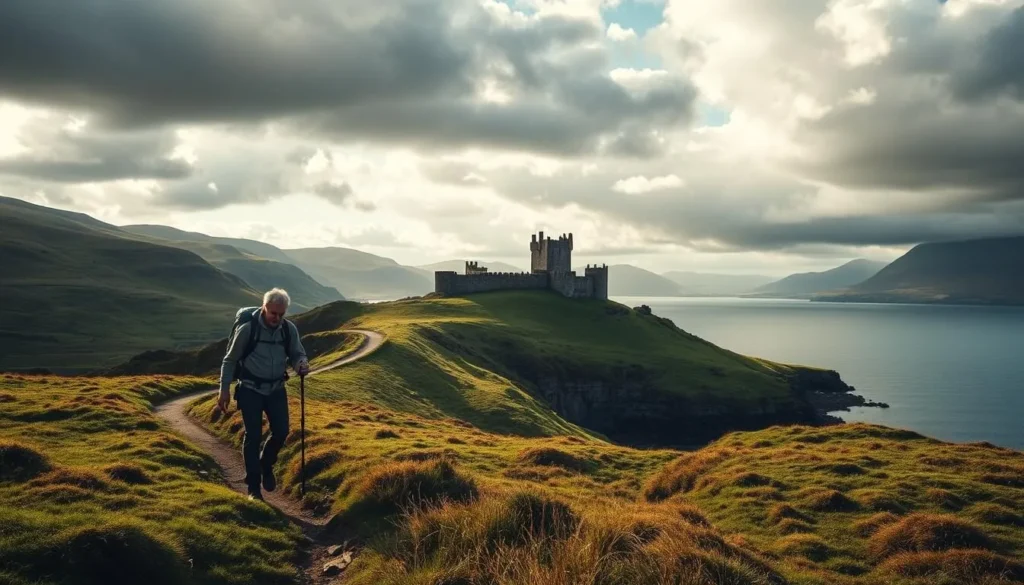
Culinary Adventures in Ulster

Culinary adventures in Ulster offer a unique blend of traditional and contemporary dining experiences. You can indulge in the rich flavors of local cuisine, from hearty Irish stews to fresh seafood.
Traditional Irish Pubs and Food
Traditional Irish pubs are the heart of Ulster’s food culture. You can enjoy local specialties like Ulster fry, boxty (potato pancakes), and Irish stew, all served with a warm welcome and a pint of local brew. The atmosphere is filled with local character, making it a must-visit for any food enthusiast.
The Old Bushmills Distillery
The Old Bushmills Distillery, established in 1608, is renowned for producing some of the world’s finest whiskey. You can take a tour to learn about the triple-distillation process and sample some of their iconic Irish whiskey brands in the 1608 bar. Located just off the Causeway Coastal Route, it’s a great detour for anyone interested in whiskey.
Ulster’s culinary scene is not just about traditional fare; it’s also a hub for innovative modern cuisine. Cities like Belfast and Derry have emerged as foodie destinations, with award-winning restaurants showcasing local ingredients such as Strangford Lough seafood and Armagh apples.
Food festivals throughout Ulster celebrate seasonal specialties, giving you the chance to experience the region’s culinary heritage alongside modern interpretations by local chefs. Whether you’re a food enthusiast or just looking to try something new, Ulster’s culinary adventures have something for everyone.
Stargazing and Outdoor Adventures
For those fascinated by the night sky, Ulster is a haven with numerous opportunities for stargazing and outdoor adventures. The region’s minimal light pollution makes it an ideal destination for observing the stars.
OM Dark Sky Park and Observatory
Northern Ireland is home to some of the darkest skies in Europe, making it a world-class destination for stargazing enthusiasts. At the OM Dark Sky Park and Observatory in Davagh Forest, County Tyrone, you’ll find state-of-the-art facilities that offer crystal-clear views of the night sky. Here, you can observe thousands of stars, planets, and even the Milky Way with exceptional clarity. For a truly unique experience, Finn Lough Resort in County Fermanagh offers bubble domes where you can stargaze from the comfort of your bed.
- Northern Ireland offers some of the darkest skies in Europe, making it a world-class destination for stargazing enthusiasts.
- The OM Dark Sky Park and Observatory provides state-of-the-art facilities for observing the night sky.
- Finn Lough Resort offers a unique stargazing experience from the comfort of your bubble dome.
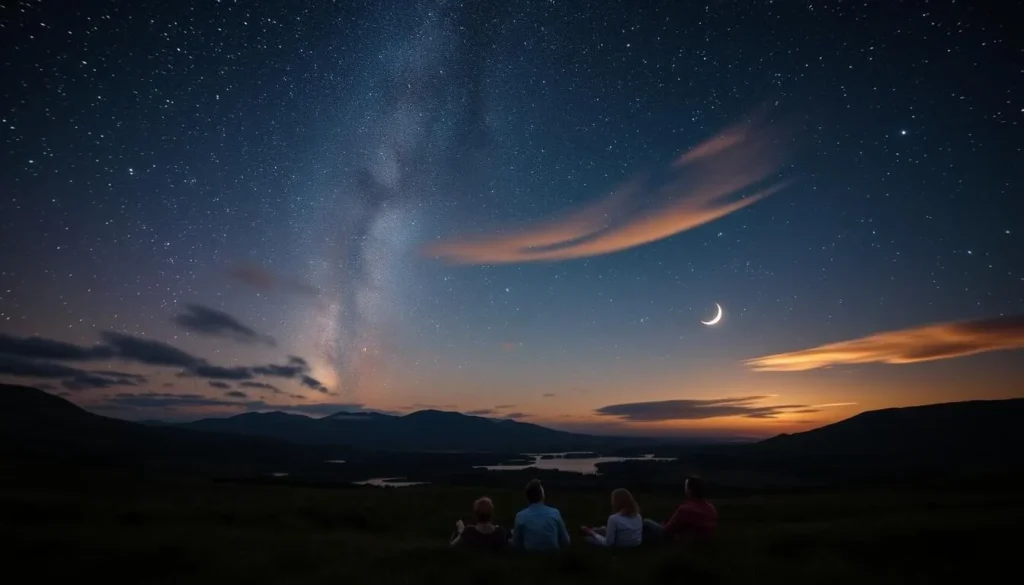
Outdoor Activities for Thrill Seekers
Beyond stargazing, Ulster caters to thrill seekers with a variety of outdoor activities. You can enjoy coasteering along the rugged Causeway Coast, go mountain biking in Rostrevor, or try surfing at spots like Portrush East Strand. The region’s varied landscape also offers spectacular views during daytime adventures, from zip-lining through forest canopies to kayaking on Strangford Lough, where you might spot seals and other wildlife in their natural habitat.
Whether you’re looking for a serene stargazing experience or an adrenaline-packed adventure, Ulster has something for everyone. With its unique blend of natural beauty and outdoor activities, you’ll find that Ulster is a destination that will leave you with unforgettable views and experiences.
Conclusion: Planning Your Ulster Adventure
Your adventure in Ulster, Ireland, is not just a trip; it’s an opportunity to experience the best of Northern Ireland’s culture, history, and natural beauty. As you plan your journey, consider balancing the must-see attractions like the Giant’s Causeway with the hidden gems that make Northern Ireland truly special.
When is the best time to visit Ulster? Each season offers different advantages—summer brings longer days but more crowds, while spring and fall offer milder weather and fewer tourists. A well-planned itinerary should include a mix of urban experiences in Belfast or Derry, coastal journeys along the Causeway Route, and inland adventures through the mountains and forests.
Transportation is key to exploring Northern Ireland effectively. Rental cars offer the most flexibility, though public transportation can connect you to major attractions if you plan your time carefully. The best things about an Ulster adventure are often the unexpected discoveries along the way—the friendly locals, the stunning viewpoints around a bend in the road, or the perfect pint at the end of a day’s journey that transforms a simple trip into an unforgettable adventure.
Starting your adventure from Northern Ireland is convenient, with Belfast being a perfect starting point for a road trip. You can choose from a variety of itineraries in the Irish Road Trip library, tailored to every length and type of trip imaginable, ensuring that your journey is as smooth and enjoyable as possible.
The above is subject to change.
Check back often to TRAVEL.COM for the latest travel tips and deals.
